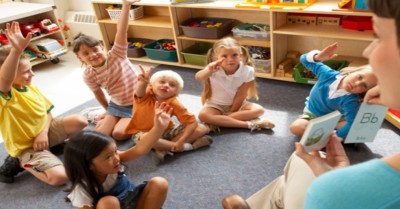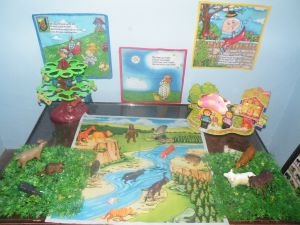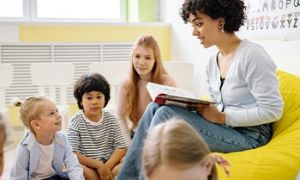Learning Styles is simply how a child can learn successfully. The ability of how a child concentrates and stores or remembers new information is their learning style.
There are 3 different learning styles. These include Visual Learners- they see to learn, Auditory Learners - they hear to learn and Kinesthetic Learners - they move to learn.
As children begin to learn about the world around them, it becomes obvious that each child has their own way of learning. Some children like to read books, others like to play outside, while another prefers to pull apart and rebuild objects.
Howard Gardner observations led him to realise that different children approach learning in different ways and that children learn better when their individual learning styles are recognized and supported.
The following article details each learning style, the set of characteristics which shows how a child may learn and the best way to teach a child based on their own individual learning style.
Visual Learners
Visual learners observe their world around them. They find it easier to learn by seeing. To understand a concept, a visual learner finds it easier to learn through charts, diagrams, pictures and videos. To remember information, they need to see it represented in pictures and objects.
Indicators
- A vivid imagination
- An interest in art: painting, drawing, or crafts
- A strong memory that relays visually-observed information
- A good sense of direction and an understanding of maps
- An aptitude in reading and a love of books
- Recognition of people, faces, and places
- A keen interest in observing the world around her
- Observes rather than talking or acting
- Not very distractible
- Notices details
- Memorizes by seeing graphics or pictures
- Enjoys advance planning
- Struggles with verbal instructions
- Typically has good handwriting and is a good speller
- Tend to be artistic and have vivid imaginations – they like to form their own images in their minds when reading or listening in order to stay engaged with the content
- Prefer to use shapes, textures, and objects to present an idea
- Notice the body language of those around them, sometimes more than the words
Have a harder time remembering things that are just spoken to them
Teaching Strategies
- Seat your visual learners close to the front, where they can see the presenter clearly
- Include meaningful visual aids to support your verbal instruction
- Use colours to cue important information
- Designate a shelf or even a closet for craft supplies. Visual learners tend to like art and creating.
- Make eye contact with your child when speaking. Visual learners are drawn into body language.
- Describe colours, sizes, and shapes when giving tasks to children who are visual learners. They will use these clues to follow-through on the information.
- Use images, graphs etc. when introducing concepts etc.
Auditory Learners
Auditory learning is a learning style in which a child learns through listening. Auditory learners need to hear what is being said in order to understand.
Indicators
- Aptitude in music, instruments, or vocal ability
- A tendency to sing along to songs or to create her own songs as she plays
- Strong verbal ability, especially through repetition of words or phrases she’s heard before
- Ability to listen well and follow verbal directions
- A love for talking and discussions
- Sharp ability to notice sounds that others don't recognize
- Perking up when she hears music or dialogue
- Talks to self
- Easily distracted
- Enjoys music, hums or sings often
- Enjoys being read to or listening to audio books
- Struggles with written instructions
- Likes to talk
- Like to contribute orally in class
- Enjoy talking with people and seem very social
- Pay close attention to sounds other than the spoken word (background noises, auditory cues, etc.)
- Prefer to hear directions as opposed to following a map
Teaching Strategies
- Seat auditory learners away from distractions
- Use good expression when speaking- don’t be monotonous!
- Have students repeat important information
- Incorporate songs or catchy phrases into your presentation
- Give the child a quiet space so he can read aloud or talk to himself.
- Find opportunities for your child to express himself verbally and listen to others do the same.
- Encourage your child to teach others how to do things. Expressing instructions orally is usually a task auditory learners excel at.
- Have various types of music available for your child to listen to each day. It helps to stimulate their learning.
Kinesthetic Learners
Kinesthetic (also called Tactile) Learning is a learning style in which a child absorbs information through touch, movement and motion. To understand a concept, a kinesthetic learner needs to be able to touch it, feel it or move it around.
Indicators
- Aptitude in sports, dance, or other physical activities
- A tendency to fidget while in her seat — she may need to move while processing information
- Frequent use of gestures when speaking or explaining things
- A love of hands-on activities and play-acting
- Enjoyment of writing, drawing, or handwriting exercises
- Early physical development, such as walking, crawling, or sitting early
- Sharp hand-eye coordination
- Frequently in motion- shaking legs, drumming fingers, etc.
- Often touches people while talking
- Enjoys solving problems by physically working through them
- Will try new things, is very outgoing
- Reading and spelling, not a priority
- Love building sets, model kits and interactive displays
Teaching Strategies
- Seat them towards the back of the room so their motion does not distract others
- Have frequent movement breaks
- Incorporate role play into your discussions
- Offer kinesthetic learner things to hold in their hands.
- Give kinesthetic learners textured paper to write on and a variety of different sized pencils and pens to choose between.
- Physical math manipulatives, such as pattern blocks and base ten blocks, can help kinesthetic learners internalize a new math concept, for example.
It's important that when teaching children a new concept or even when doing group time that you try and cover each of the different learning styles. Even though children show indicators of all three different learning styles, you will notice that each child has a particular strength towards one. Ensure that all children are given an opportunity to understand what is being said, gets actively involved and you help each child become a successful learner.
References:
- Mead, Sarah "Auditory, Visual & Kinesthetic: Helping Kids Succeed Through Different Learning Styles", Whitby School's Learning Blog, 12th December 2016.
- O, Chris "Speech Buddies Parents’ Corner – Is Your Child a Visual Learner" Speech buddies, 01 August 2013
- Pennington, Molly, "How to Identify Your Child’s Learning Style" 6th January 2015
"Is Your Child A Visual Learner", The School Run







 Open ended questions cannot be responded to with one word answers such as yes or no. These types of questions enables a child to provide
Open ended questions cannot be responded to with one word answers such as yes or no. These types of questions enables a child to provide During your child’s preschool years, an important milestone begins to emerge. This is the development of pre-writing skills. Pre-writing skills are used to encourage, develop
During your child’s preschool years, an important milestone begins to emerge. This is the development of pre-writing skills. Pre-writing skills are used to encourage, develop Open ended materials enables children to play freely. They are objects that have no rules to follow, use or function. Raw materials that can be
Open ended materials enables children to play freely. They are objects that have no rules to follow, use or function. Raw materials that can be An Acknowledgment of the Country is a way of showing respect for the Traditional Owners and can be given by both non-Indigenous people and Aboriginal
An Acknowledgment of the Country is a way of showing respect for the Traditional Owners and can be given by both non-Indigenous people and Aboriginal Language plays an important role in a child’s development. It enables a child to communicate effectively with their family, learn at school, socialize with friends,
Language plays an important role in a child’s development. It enables a child to communicate effectively with their family, learn at school, socialize with friends, Like adults, children have to deal with their own stress in life. Moving house, starting a new school, preparing for a new sibling - these are
Like adults, children have to deal with their own stress in life. Moving house, starting a new school, preparing for a new sibling - these are Playdough is such a versatile material. It provides numerous benefits to children as they manipulate it, it is safe and soothing and provides children with
Playdough is such a versatile material. It provides numerous benefits to children as they manipulate it, it is safe and soothing and provides children with Teaching children about sustainability enables them to appreciate and respect the natural environment. Early childhood services can provide meaningful hand on learning experiences in order
Teaching children about sustainability enables them to appreciate and respect the natural environment. Early childhood services can provide meaningful hand on learning experiences in order Recycling is an important concept that teaches children to care for the environment. It encourages children to be responsible and show a growing appreciating for
Recycling is an important concept that teaches children to care for the environment. It encourages children to be responsible and show a growing appreciating for When children apply paint to paper, glue things together, or pound a lump of clay, they experiment with colour, shape design and texture.
When children apply paint to paper, glue things together, or pound a lump of clay, they experiment with colour, shape design and texture.



